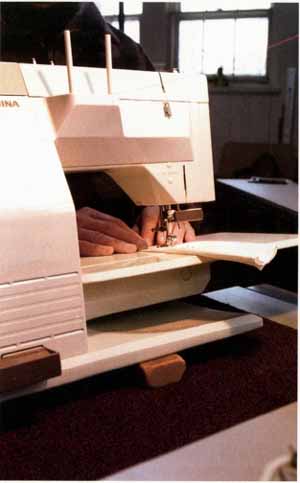Cutting fabric isn't my favorite part of sewing. But there is one thing I
dislike even more: clearing the table of all books, mail, and other stuff to
make room for cutting. Before I even pick up the scissors, I’m in a bad mood.
The Johnny G Tilt Do you remember the desk you had in grade school? I bet its surface was slightly tilted toward you just like a drafting table or an old- fashioned accountant’s table. That’s because somebody knew that writing for long periods on a flat surface was not a very comfortable thing to do. Sewing on a flat surface isn’t the most comfortable way to sew either. Try this: Buy two 1-in. art-gum erasers and put them under the back side of your machine to tilt the machine slightly toward you (see the photo at right). The erasers will not let the machine slide around or jump into your lap. Try sewing on the tilted machine for a few hours; it will feel different, but the tilt will allow to look down on the needle instead of across at it. It may change the way you sew.
|
Use the largest flat surface in your house—usually the dining room or kitchen table—for cutting fabric. Once you remove the income tax forms and the kids’ homework, you might be able to use it for sewing. The green felt side of protective dining-room-table pads is just about perfect for cutting. You can stick pins in it, too.
Whatever surface you use, it must be at the right height for you. I like to use the kitchen counter rule when talking about the right height of a cutting table: Do you find your kitchen counters too low to comfortably prepare food for more than a few minutes? If you have to bend over all the time, you are going to get tired, or worse, get back trouble. You can easily test this rule by placing some food on a 1-in. - to 2-in. -thick cutting board to see if the higher height feels better to you. If you find the countertop too high, place the cutting board on a bowl in the sink or on an open drawer to see how low is comfortable for you. Try cutting some vegetables at that height for a few meals to see if you like it. When you find the right height for you, measure it and make that your cutting table height.
If you have the space, here’s an easy way to create a large cutting surface. Buy a standard 4-ft. by s-ft. piece of plywood and cover it with either linoleum, if you prefer a smooth work top, or a mattress pad covered with a cotton sheet or linen tablecloth. (The tooth of the cloth covering will grab and hold your project just like the flannel or felt board used in schools. You can iron on it, too.) Set the plywood on the dining-room or kitchen table. If you need more height, place some 2x4s on the table first, then the plywood on top of that. You can also set up sawhorses to hold the plywood at the right height.
I see lots of portable cutting tables for sale in sewing magazines and wonder how you can cut on such a wobbly piece of equipment. Whatever table you use, make sure it's stable and wobble-free. Finally, when I was working on a very large quilt, my mother-in-law suggested I use the floor. Why didn’t I think of that? If the carpet is thin enough (like the commercial carpeting I have in my sewing room, for example), you can even stick pins in it. Just get down on your hands and knees and get to work!

